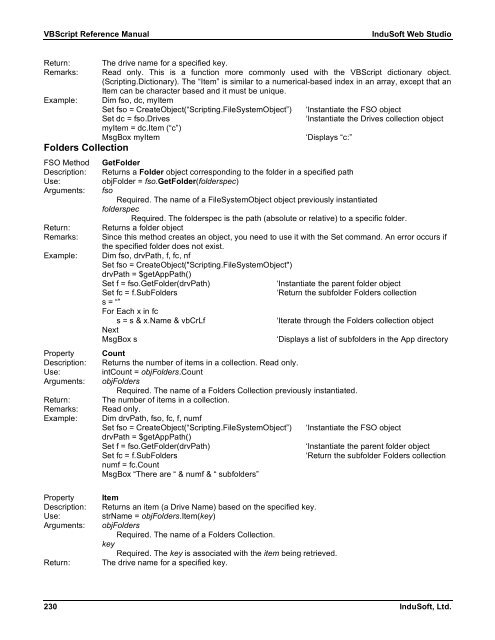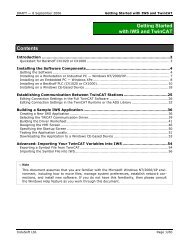VBScript Reference Manual for InduSoft Web Studio
VBScript Reference Manual for InduSoft Web Studio
VBScript Reference Manual for InduSoft Web Studio
You also want an ePaper? Increase the reach of your titles
YUMPU automatically turns print PDFs into web optimized ePapers that Google loves.
<strong>VBScript</strong> <strong>Reference</strong> <strong>Manual</strong> <strong>InduSoft</strong> <strong>Web</strong> <strong>Studio</strong><br />
Return: The drive name <strong>for</strong> a specified key.<br />
Remarks: Read only. This is a function more commonly used with the <strong>VBScript</strong> dictionary object.<br />
(Scripting.Dictionary). The “Item” is similar to a numerical-based index in an array, except that an<br />
Item can be character based and it must be unique.<br />
Example: Dim fso, dc, myItem<br />
Set fso = CreateObject(“Scripting.FileSystemObject”) ‘Instantiate the FSO object<br />
Set dc = fso.Drives ‘Instantiate the Drives collection object<br />
myItem = dc.Item (“c”)<br />
MsgBox myItem ‘Displays “c:”<br />
Folders Collection<br />
FSO Method GetFolder<br />
Description: Returns a Folder object corresponding to the folder in a specified path<br />
Use: objFolder = fso.GetFolder(folderspec)<br />
Arguments: fso<br />
Required. The name of a FileSystemObject object previously instantiated<br />
folderspec<br />
Required. The folderspec is the path (absolute or relative) to a specific folder.<br />
Return: Returns a folder object<br />
Remarks: Since this method creates an object, you need to use it with the Set command. An error occurs if<br />
the specified folder does not exist.<br />
Example: Dim fso, drvPath, f, fc, nf<br />
Set fso = CreateObject("Scripting.FileSystemObject")<br />
drvPath = $getAppPath()<br />
Set f = fso.GetFolder(drvPath) ‘Instantiate the parent folder object<br />
Set fc = f.SubFolders ‘Return the subfolder Folders collection<br />
s = “”<br />
For Each x in fc<br />
s = s & x.Name & vbCrLf ‘Iterate through the Folders collection object<br />
Next<br />
MsgBox s ‘Displays a list of subfolders in the App directory<br />
Property Count<br />
Description: Returns the number of items in a collection. Read only.<br />
Use: intCount = objFolders.Count<br />
Arguments: objFolders<br />
Required. The name of a Folders Collection previously instantiated.<br />
Return: The number of items in a collection.<br />
Remarks: Read only.<br />
Example: Dim drvPath, fso, fc, f, numf<br />
Set fso = CreateObject(“Scripting.FileSystemObject”) ‘Instantiate the FSO object<br />
drvPath = $getAppPath()<br />
Set f = fso.GetFolder(drvPath) ‘Instantiate the parent folder object<br />
Set fc = f.SubFolders ‘Return the subfolder Folders collection<br />
numf = fc.Count<br />
MsgBox “There are “ & numf & “ subfolders”<br />
Property Item<br />
Description: Returns an item (a Drive Name) based on the specified key.<br />
Use: strName = objFolders.Item(key)<br />
Arguments: objFolders<br />
Required. The name of a Folders Collection.<br />
key<br />
Required. The key is associated with the item being retrieved.<br />
Return: The drive name <strong>for</strong> a specified key.<br />
230 <strong>InduSoft</strong>, Ltd.



